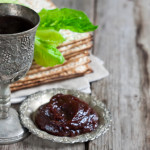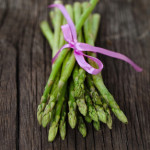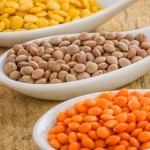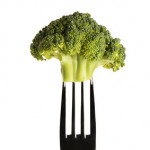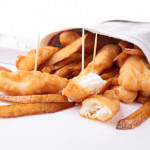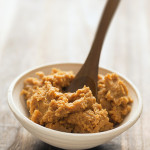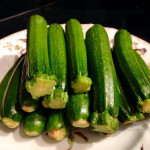Asparagus
Nothing quite says spring like asparagus, which has a rather short season, which is typically from February to June.
Thickness really has nothing to do with quality. Asparagus is a perennial; more mature plantings tend to yield thicker stalks, and any size will be tender as long as it’s freshly cut. Look for bright apple green spears and tightly closed purplish heads; the stalks should be glossy, firm, and unwrinkled, with just a little white toward the base.
The question that many people have about Asparagus is whether to peel or not to peel. I believe it is quite unnecessary, and for the effort, it just doesn’t make noticeably more asparagus flesh available for eating. Instead, bend the cut end of each spear, snapping off the woody part where it breaks naturally (usually about two-thirds of the way down the stalk). The balance of the spear will be tender to the bite.
Extend the freshness of asparagus by keeping the spears hydrated. When you get the asparagus home from the market, trim the bottom 1/2 inch or so from each stem, and stand the bunch upright in a large coffee cup. Add water just to cover the ends of the stems, and then cover the top of the bunch with a plastic bag. Or you could trim 1/2 inch off the base of the stalks, wrap the bottoms in a damp paper towel, and slip the spears into a plastic bag, leaving the bag open. In either case, make sure to refrigerate the asparagus, adding more water to the cup or dampening the paper towel as needed. The asparagus should stay fresh for up to 3 days.
“Work With What You Got!”
© Victoria Hart Glavin Tiny New York Kitchen
Peas
There are several types of fresh peas, all of which are available nearly year round these days, but they are at their peak during the spring and early summer months. Like corn, the natural sugar in peas converts quickly to starch, so make sure to buy peas fresh, store them in the refrigerator, and use them within a day or two.
English shell peas are the familiar round green pea. Frozen tiny tender green peas, while enjoyable and convenient throughout the winter months, bear little resemblance to the texture and bright flavor of fresh peas. The springtime ritual of shelling peas is just as satisfying as shucking summer corn, and their flavor and texture are worth every minute.
When shopping for English peas, look for bright green smooth, succulent pods filled with evenly plump, round seeds. The freshness of the pods is an indication of the freshness of the peas. For the most reliable test, pop open a pod and taste a pea. Fresh peas should taste sweet and grassy. A pound of English shell peas in their pods yields about 2 cups of shelled peas, which translates into 2 to 3 servings.
Both sugar snaps and snow peas are edible pod peas. There is no shelling required. As their name implies, sugar snaps are delightfully sweet. Sugar snaps are delicious raw, but their flavor is enhanced with a brief cooking. As with all other peas, look for bright, smooth, succulent, tender green pods with fresh looking stems.
Happy Spring!
“Work With What You Got!”
© Victoria Hart Glavin Tiny New York Kitchen
Lentils
The lentil is a Eurasian herb grown for its small, flat, edible seeds and are considered a legume. They are lens shaped (the word comes from the Latin lens, “lentil”), variously colored on the outside, and yellow/orange on the inside. The earliest written mention of lentils is in the book of Genesis: Esau sold his birthright in exchange for a dish of lentils. Lentils are high in fiber, vegetable proteins, and complex carbohydrates and fairly rich in iron and protein; they are low in sodium and fat-free.
Work With What You Got!”
© Victoria Hart Glavin Tiny New York Kitchen
Broccoli
Broccoli is a plant in the cabbage family with tight heads of green, purple, or white flower buds that are cooked and eaten as a vegetable. Broccoli comes from the Latin brachium, “strong arm/strong branch,” and comes from a reference to its shape. Broccoli is the Italian plural of broccoli, “cabbage sprout/head,” and literally means “little shoots.”
When shopping for broccoli look for heads that are dark green or purplish and tightly clustered. The stalks should be fresh looking and not tough or woody.
Refrigerate broccoli for up to five days in a perforated bag. Broccoli can be blanched and frozen for up to 1 year.
To remove dirt simply soak a head of broccoli upside down in a bowl of cold water for 20 minutes. Cut or peel off any stalk parts that are tough. Cut into spears. Broccoli can be precooked by blanching or parboiling.
Eat more broccoli!
Work With What You Got!”
© Victoria Hart Glavin Tiny New York Kitchen
Miso
Miso is a highly concentrated fermented soybean paste, made from a combination of soybeans and grains such as rice or barley, miso is widely used in Japanese cooking – from sauces and soups to main dishes – and is made in different strengths, varying by color. Red miso has the strongest flavor, golden miso is fairly mild, and white miso is mellow and slightly sweet. Look for miso in health food stores and Asian markets.
“Work With What You Got!”
© Victoria Hart Glavin Tiny New York Kitchen
Baby Zucchini
Baby zucchini are very tender, tasty simple vegetables that have more flavor than the larger Italian zucchini as well as being very easy to prepare and enjoy. Archeologists think that they are indigenous to Central America. They are very nutritious and are a good source of Vitamin A, C B6, thiamin, niacin, and Pantothenic acid. Baby zucchini are also a very good source of fiber, protein, folate, iron, magnesium, phosphorus, zinc, and copper.
Quick Roast: Cut lengthwise and roast with sliced onions for 25 minutes at 350 degrees.
Blanching: Drop zucchini into boiling water for 1 to 2 minutes. Then remove to an ice bath. Zucchini are now ready to cut lengthwise and add to salads, sauté with mushrooms, onions, and garlic.
Grilling: Brush zucchini with olive oil, sprinkle with fresh herbs or spices, and either grill on BBQ or grill in a grill pan for about 2 to 3 minutes on each side.
Microwave: Place zucchini in ziplock bag. Cut corner of bag and microwave on high for 3 to 4 minutes.
For Salads: Baby zucchini makes a great salad addition. Shred or grate raw and add to salads, or cut lengthwise and add to vegetable platters.
Raw: To eat raw make sure to wash before eating.
“Work With What You Got!”
© Victoria Hart Glavin Tiny New York Kitchen
In case things get too hot, a teaspoon of sugar after eating something REALLY spicy will neutralize the heat sensation!
Drinking From Bottles, Cans, And Brown Paper Bags!
For as long as beverages have been available in disposable containers, etiquette books have advised people not to drink out of cartons, bottles, and cans. The only exception to this rule was the consumption of beer and soda at outdoor picnics or barbecues, where suitable glasses might not be available.
Nowadays, however, you can buy everything from green tea to chocolate soy milk in packages made from glass, plastic, paper, and aluminum – or a variety of combinations. Convenient little juice boxes come with their own plastic straws, and sports drinks come in wide-mouth containers for easy gulping. People even wear water bottles with designer labels, like handbags as they traipse through the mall.
Drinking directly from bottles or cans might be the most convenient option on the tennis court or on the go, but when it comes to serving beverages in your home, drinks should be drunk from a glass, never a can or bottle. And definitely not from the milk carton.
“Work With What You Got!”
© Victoria Hart Glavin Tiny New York Kitchen

